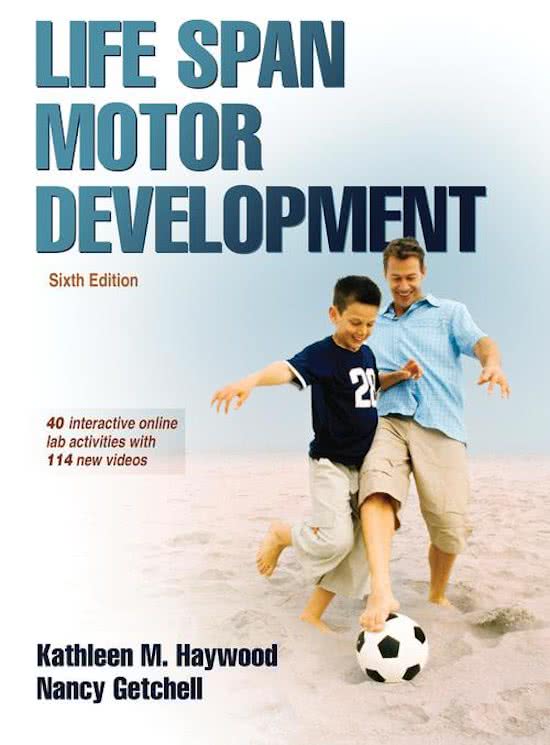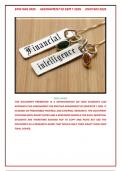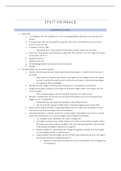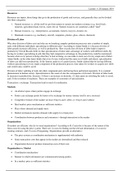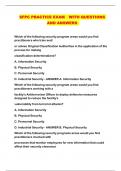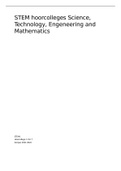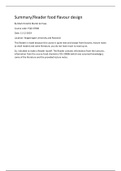Chapter 8: Development of Ballistic skills
Ballistic skills skills are those in which a person applies force to an object in order to project it.
The ballistic skills of throwing, kicking and striking have similar developmental patterns because the
mechanical principles involved in projecting objects are basically the same.
Overarm throwing
The type of throw that a person uses, especially among children, often depends on task constraints,
particularly rules and the size of the ball. >two-hand underhand throw, one-hand underhand throw,
sidearm throw, two/one-hand overarm throw.
Characteristics of minimal throwing skill
Children, especially under 3 years of age, tend to be restricted to arm action alone;
Does not step into the throw or use much trunk action;
Executes the throw by elbow extension alone.
Proficient overarm throwing
An advanced, forceful throw for distance involves the following movement patterns:
The weight shifts to the back foot; the trunk rotates back; and the arm makes a circular,
downward backswing* for a windup.
*The backswing is the backward, or takeaway, movement to put the arm, leg, or racket in a
position to move ballistically forward to project an object.
The leg opposite the throwing arm steps forward to increase the distance over which the
thrower applies force to the ball and to allow full trunk rotation.
The trunk rotates forward to add force to the throw. To produce maximal force, trunk
rotation is “differentiated,” which means the lower torso leads the upper torso, resulting in a
movement that looks like the body “opens up”.
The trunk bends laterally, away from the side of the throwing arm.
The upper arm forms a right angle with the trunk and comes forward just as (or slightly after)
the shoulders rotate to a front-facing position. This means that from the side, you can see
the upper arm within the outline of the trunk.
The thrower holds the elbow at a right angle during the forward swing, extending the arm
when the shoulders react the front-facing position. Extending the arm just before release
lengthens the radius of the throwing arc.
The forearm lags behind the trunk and upper arm during the forward swing. While the upper
trunk is rotating forward, the forearm and hand appear to be stationary or to move down or
back. The forearm lags until the upper trunk and shoulders actually rotate in he direction of
the throw (the front-facing position).
The follow-through dissipates the force of the throw over distance. The greater portion of
wrist flexion comes during follow-through, after the thrower releases the ball.
Dissipating force after release allows maximal speed of movement while the ball is in the
hand.
The thrower carries out the movements of the body segments sequentially, progressively
adding the contributions of each part to the force of the throw. Generally, the sequence is as
follows:
o Forward step and pelvic rotation
o Upper spine rotation and upper arm swing
o Upper arm inward rotation and elbow extension
o Release
o Follow-through
, Developmental changes in overarm throwing
Validated developmental sequences; are sequences of advances in the performance of a skill that
have been determined by longitudinal study and shown to fall in the same fixed order for all
individuals.
For throwing> arm action and trunk action.
Table 8.1 Developmental sequence for throwing
Action
Trunk action in throwing and striking for force
Step 1. No trunk action or forward or backward movements. Only the arm is active in force
production. Sometimes the forward thrust of the arm pulls the trunk into a passive left
rotation (assuming a right-handed throw), but no twist-up precedes that action. If trunk
action occurs, it accompanies the forward thrust of the arm by flexing forward at the hips.
Preparatory extension sometimes precedes forward hip flexion.
Step 2. Upper trunk rotation or total trunk (“block”) rotation. The spine and pelvis rotate
away from the intended line of flight and then simultaneously begin forward rotation, acting
as a unit, or “block”. Occasionally, only the upper spine twists away, then forward the
direction of force. The pelvis, then, remains fixed, facing the line of flight, or joints the rotary
movement after forward spinal rotation has begun.
Step 3. Differentiated rotation. The pelvis precedes the upper spine in initiating forward
rotation. The child twists away from the intended line of ball flight and then begins forward
rotation with the pelvis while the upper spine is still twisting away.
Backswing, humerus, and forearm action in the overarm throw for force preparatory arm backswing
component.
Step 1. No backswing. The ball in the hand moves directly forward to release from the arm’s
original position when the hand first grasped the ball.
Step 2. Elbow and humeral flexion. The ball moves away from the intended line of flight to a
position behind or alongside the head by upward flexion of the humerus and concomitant
elbow flexion.
Step 3. Circular, upward backswing. The ball moves away from the intended line of flight to
position behind the head via a circular overhead movement with elbow extended, or an
oblique swing back, or a vertical lift from the hip.
Step 4. Circular, downward backswing. The ball moves away form the intended line of flight
to a position behind the head via a circular down-and-back motion, which carries the hand
below the waist.
Humerus (upper arm) action component during forward swing.
Step 1. Humerus oblique. The upper arm moves forward to ball release in a plane that
intersects the trunk obliquely above or below the horizontal line of the shoulders.
Occasionally, during the backswing, the upper arm is placed at a right angle to the trunk, with
the elbow pointing toward the target. It maintains this fixed position during the throw.
Step 2. Humerus aligned but independent. The upper arm moves forward to ball release in a
plane horizontally aligned with the shoulder, forming a right angle between humerus and
trunk. By the time the shoulders (upper spine) reach front-facing, the upper arm and elbow
have moved independently ahead of the outline of the body (as seen from the side) via
horizontal adduction at the shoulder.
Step 3. Humerus lags. The upper arm moves forward to ball release horizontally aligned, but
at the moment the shoulders (upper spine) reach front-facing, the upper arm remains within
Ballistic skills skills are those in which a person applies force to an object in order to project it.
The ballistic skills of throwing, kicking and striking have similar developmental patterns because the
mechanical principles involved in projecting objects are basically the same.
Overarm throwing
The type of throw that a person uses, especially among children, often depends on task constraints,
particularly rules and the size of the ball. >two-hand underhand throw, one-hand underhand throw,
sidearm throw, two/one-hand overarm throw.
Characteristics of minimal throwing skill
Children, especially under 3 years of age, tend to be restricted to arm action alone;
Does not step into the throw or use much trunk action;
Executes the throw by elbow extension alone.
Proficient overarm throwing
An advanced, forceful throw for distance involves the following movement patterns:
The weight shifts to the back foot; the trunk rotates back; and the arm makes a circular,
downward backswing* for a windup.
*The backswing is the backward, or takeaway, movement to put the arm, leg, or racket in a
position to move ballistically forward to project an object.
The leg opposite the throwing arm steps forward to increase the distance over which the
thrower applies force to the ball and to allow full trunk rotation.
The trunk rotates forward to add force to the throw. To produce maximal force, trunk
rotation is “differentiated,” which means the lower torso leads the upper torso, resulting in a
movement that looks like the body “opens up”.
The trunk bends laterally, away from the side of the throwing arm.
The upper arm forms a right angle with the trunk and comes forward just as (or slightly after)
the shoulders rotate to a front-facing position. This means that from the side, you can see
the upper arm within the outline of the trunk.
The thrower holds the elbow at a right angle during the forward swing, extending the arm
when the shoulders react the front-facing position. Extending the arm just before release
lengthens the radius of the throwing arc.
The forearm lags behind the trunk and upper arm during the forward swing. While the upper
trunk is rotating forward, the forearm and hand appear to be stationary or to move down or
back. The forearm lags until the upper trunk and shoulders actually rotate in he direction of
the throw (the front-facing position).
The follow-through dissipates the force of the throw over distance. The greater portion of
wrist flexion comes during follow-through, after the thrower releases the ball.
Dissipating force after release allows maximal speed of movement while the ball is in the
hand.
The thrower carries out the movements of the body segments sequentially, progressively
adding the contributions of each part to the force of the throw. Generally, the sequence is as
follows:
o Forward step and pelvic rotation
o Upper spine rotation and upper arm swing
o Upper arm inward rotation and elbow extension
o Release
o Follow-through
, Developmental changes in overarm throwing
Validated developmental sequences; are sequences of advances in the performance of a skill that
have been determined by longitudinal study and shown to fall in the same fixed order for all
individuals.
For throwing> arm action and trunk action.
Table 8.1 Developmental sequence for throwing
Action
Trunk action in throwing and striking for force
Step 1. No trunk action or forward or backward movements. Only the arm is active in force
production. Sometimes the forward thrust of the arm pulls the trunk into a passive left
rotation (assuming a right-handed throw), but no twist-up precedes that action. If trunk
action occurs, it accompanies the forward thrust of the arm by flexing forward at the hips.
Preparatory extension sometimes precedes forward hip flexion.
Step 2. Upper trunk rotation or total trunk (“block”) rotation. The spine and pelvis rotate
away from the intended line of flight and then simultaneously begin forward rotation, acting
as a unit, or “block”. Occasionally, only the upper spine twists away, then forward the
direction of force. The pelvis, then, remains fixed, facing the line of flight, or joints the rotary
movement after forward spinal rotation has begun.
Step 3. Differentiated rotation. The pelvis precedes the upper spine in initiating forward
rotation. The child twists away from the intended line of ball flight and then begins forward
rotation with the pelvis while the upper spine is still twisting away.
Backswing, humerus, and forearm action in the overarm throw for force preparatory arm backswing
component.
Step 1. No backswing. The ball in the hand moves directly forward to release from the arm’s
original position when the hand first grasped the ball.
Step 2. Elbow and humeral flexion. The ball moves away from the intended line of flight to a
position behind or alongside the head by upward flexion of the humerus and concomitant
elbow flexion.
Step 3. Circular, upward backswing. The ball moves away from the intended line of flight to
position behind the head via a circular overhead movement with elbow extended, or an
oblique swing back, or a vertical lift from the hip.
Step 4. Circular, downward backswing. The ball moves away form the intended line of flight
to a position behind the head via a circular down-and-back motion, which carries the hand
below the waist.
Humerus (upper arm) action component during forward swing.
Step 1. Humerus oblique. The upper arm moves forward to ball release in a plane that
intersects the trunk obliquely above or below the horizontal line of the shoulders.
Occasionally, during the backswing, the upper arm is placed at a right angle to the trunk, with
the elbow pointing toward the target. It maintains this fixed position during the throw.
Step 2. Humerus aligned but independent. The upper arm moves forward to ball release in a
plane horizontally aligned with the shoulder, forming a right angle between humerus and
trunk. By the time the shoulders (upper spine) reach front-facing, the upper arm and elbow
have moved independently ahead of the outline of the body (as seen from the side) via
horizontal adduction at the shoulder.
Step 3. Humerus lags. The upper arm moves forward to ball release horizontally aligned, but
at the moment the shoulders (upper spine) reach front-facing, the upper arm remains within


